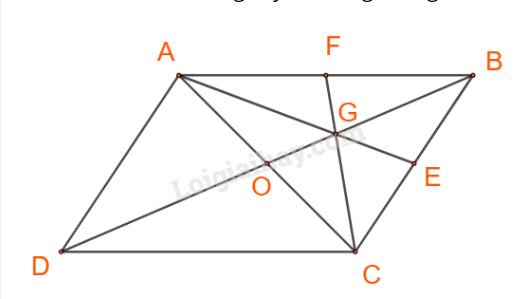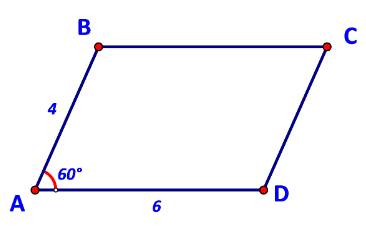Cho hình bình hành ABCD, tâm O. Gọi M là trung điểm AB. Phân tích \(\overrightarrow{CM}\) theo 2 vecto \(\overrightarrow{DA}\) và \(\overrightarrow{DB}\)
Cho hình bình hành ABCD. Gọi M là trung điểm của cạnh BC. Hãy biểu thị \(\overrightarrow {AM} \) theo hai vecto \(\overrightarrow {AB} \) và \(\overrightarrow {AD} \).
Từ M kẻ đường thẳng song song với AB, cắt AD tại E.
Khi đó tứ giác ABME là hình bình hành.
Do đó: \(\overrightarrow {AM} = \overrightarrow {AB} + \overrightarrow {AE} \).
Dễ thấy: \(AE = BM = \frac{1}{2}BC = \frac{1}{2}AD\)
\( \Rightarrow \overrightarrow {AE} = \frac{1}{2}\overrightarrow {AD} \)
\( \Rightarrow \overrightarrow {AM} = \overrightarrow {AB} + \frac{1}{2}\overrightarrow {AD} \)
Vậy \(\overrightarrow {AM} = \overrightarrow {AB} + \frac{1}{2}\overrightarrow {AD} \)
Chú ý khi giải
+) Dựng hình hình hành sao cho đường chéo là vecto cần biểu thị, 2 cạnh của nó song song với giá của hai vecto đang biểu thị theo.
cho hình bình hành ABCD tâm O. CMR:
a) \(\overrightarrow{CO}\) - \(\overrightarrow{OB}\) = \(\overrightarrow{BA}\)
b)\(\overrightarrow{AB}\) - \(\overrightarrow{BC}\) = \(\overrightarrow{DB}\)
c)\(\overrightarrow{DA}\) - \(\overrightarrow{DB}\) = \(\overrightarrow{OD}\) - \(\overrightarrow{OC}\)
d)\(\overrightarrow{DA}\) - \(\overrightarrow{DB}\) + \(\overrightarrow{DC}\) = \(\overrightarrow{0}\)
Cho ABCD là hình bình hành. Đặt \(\overrightarrow {AB} = \overrightarrow a ,\overrightarrow {AD} = \overrightarrow b .\) Gọi G là trọng tâm của tam giác ABC. Biểu thị các vecto \(\overrightarrow {AG} ,\overrightarrow {CG} \) theo hai vecto \(\overrightarrow a ,\overrightarrow b .\)
Cách 1:
Gọi O là giao điểm của AC và BD.

Ta có:
\(\begin{array}{l}\overrightarrow {AG} = \overrightarrow {AB} + \overrightarrow {BG} = \overrightarrow a + \overrightarrow {BG} ;\\\overrightarrow {CG} = \overrightarrow {CB} + \overrightarrow {BG} = \overrightarrow {DA} + \overrightarrow {BG} = - \overrightarrow b + \overrightarrow {BG} ;\end{array}\)(*)
Lại có: \(\overrightarrow {BD} =\overrightarrow {BA} + \overrightarrow {AD} = - \overrightarrow a + \overrightarrow b \).
\(\overrightarrow {BG} ,\overrightarrow {BD} \) cùng phương và \(\left| {\overrightarrow {BG} } \right| = \frac{2}{3}BO = \frac{1}{3}\left| {\overrightarrow {BD} } \right|\)
\( \Rightarrow \overrightarrow {BG} = \frac{1}{3}\overrightarrow {BD} = \frac{1}{3}\left( { - \overrightarrow a + \overrightarrow b } \right)\)
Do đó (*) \( \Leftrightarrow \left\{ \begin{array}{l}\overrightarrow {AG} = \overrightarrow a + \overrightarrow {BG} = \overrightarrow a + \frac{1}{3}\left( { - \overrightarrow a + \overrightarrow b } \right) = \frac{2}{3}\overrightarrow a + \frac{1}{3}\overrightarrow b ;\\\overrightarrow {CG} = -\overrightarrow b + \overrightarrow {BG} = -\overrightarrow b + \frac{1}{3}\left( { - \overrightarrow a + \overrightarrow b } \right) = - \frac{1}{3}\overrightarrow a - \frac{2}{3}\overrightarrow b ;\end{array} \right.\)
Vậy \(\overrightarrow {AG} = \frac{2}{3}\overrightarrow a + \frac{1}{3}\overrightarrow b ;\;\overrightarrow {CG} = - \frac{1}{3}\overrightarrow a - \frac{2}{3}\overrightarrow b .\)
Cách 2:
Gọi AE, CF là các trung tuyến trong tam giác ABC.

Ta có:
\(\overrightarrow {AG} = \frac{2}{3}\overrightarrow {AE} = \frac{2}{3}.\frac{1}{2}\left( {\overrightarrow {AB} + \overrightarrow {AC} } \right) = \frac{2}{3}.\frac{1}{2}\left[ {\overrightarrow {AB} + \left( {\overrightarrow {AB} + \overrightarrow {AD} } \right)} \right] \\= \frac{1}{3}\left( {2\overrightarrow a + \overrightarrow b } \right) = \frac{2}{3}\overrightarrow a + \frac{1}{3}\overrightarrow b \)
\(\overrightarrow {CG} = \frac{2}{3}\overrightarrow {CF} = \frac{2}{3}.\frac{1}{2}\left( {\overrightarrow {CA} + \overrightarrow {CB} } \right) = \frac{2}{3}.\frac{1}{2}\left[ {\left( {\overrightarrow {CB} + \overrightarrow {CD} } \right) + \overrightarrow {CB} } \right] = \frac{1}{3}\left( {2\overrightarrow {CB} + \overrightarrow {CD} } \right) = \frac{1}{3}\left( { - 2\overrightarrow {AD} - \overrightarrow {AB} } \right) = - \frac{1}{3}\overrightarrow a - \frac{2}{3}\overrightarrow b \)
Vậy \(\overrightarrow {AG} = \frac{2}{3}\overrightarrow a + \frac{1}{3}\overrightarrow b ;\;\overrightarrow {CG} = - \frac{1}{3}\overrightarrow a - \frac{2}{3}\overrightarrow b .\)
Cho hình bình hành ABCD . Ba điểm M,N,P thỏa mãn \(\overrightarrow{MA}+3\overrightarrow{MB},2\overrightarrow{NB}+3\overrightarrow{NC},\overrightarrow{PM}+2\overrightarrow{PN}=\overrightarrow{0}\) Phân tích vecto AP theo hai vecto \(\overrightarrow{a}=\overrightarrow{AB},\overrightarrow{b}=\overrightarrow{BD}\). Ta được
Cho hình bình hành ABCD, tâm O
a. Chứng minh \(\overrightarrow{BA}+\overrightarrow{BC}+2\overrightarrow{DO}=\overrightarrow{0}\)
b. Gọi M là trung điểm AB. Biểu diễn \(\overrightarrow{CM}\) theo 2 vecto \(\overrightarrow{DA}\) và\(\overrightarrow{DB}\)
\(\overrightarrow{BA}+\overrightarrow{BC}+2\overrightarrow{DO}=\overrightarrow{BD}+\overrightarrow{DB}=\overrightarrow{0}\)
\(\overrightarrow{CM}=\frac{\overrightarrow{CA}+\overrightarrow{CB}}{2}=\frac{1}{4}\left(\overrightarrow{CD}+\overrightarrow{CB}\right)+\frac{1}{2}\overrightarrow{CB}=\frac{1}{4}\overrightarrow{CD}+\frac{3}{4}\overrightarrow{CB}\)
Cho hình bình hành ABCD tâm O. Xác định vị trí điểm M thỏa mãn \(\overrightarrow{OB}+\overrightarrow{OC}=\overrightarrow{AM}\). Cho tam giác ABC. Gọi M, N, P lần lượt là trung điểm các cạnh AB, BC, CA và dựng điểm K sao cho \(\overrightarrow{MK}+\overrightarrow{CN}=\overrightarrow{0}\). Khi đó, điểm K trùng với
Bài 1:
Gọi K là trung điểm của BC
ABCD là hình bình hành
=>AC cắt BD tại trung điểm của mỗi đường
=>O là trung điểm chung của AC và BD
Xét ΔCAB có
O,K lần lượt là trung điểm của CA,CB
=>OK là đường trung bình
=>OK//AB và \(OK=\dfrac{AB}{2}\)
=>\(\overrightarrow{OK}=\dfrac{\overrightarrow{AB}}{2}\)
=>\(\overrightarrow{AB}=2\cdot\overrightarrow{OK}\)
Xét ΔOBC có OK là đường trung tuyến
nên \(\overrightarrow{OB}+\overrightarrow{OC}=2\cdot\overrightarrow{OK}\)
=>\(\overrightarrow{AB}=\overrightarrow{OB}+\overrightarrow{OC}\)
=>M trùng với B
Bài 2:
Xét ΔABC có
M,P lần lượt là trung điểm của AB,AC
=>MP là đường trung bình của ΔABC
=>MP//BC và MP=BC/2
=>MP=CN
mà MP//NC
nên MPCN là hình bình hành
=>\(\overrightarrow{MP}=\overrightarrow{NC}\)
=>\(\overrightarrow{MP}=-\overrightarrow{CN}\)
=>\(\overrightarrow{MP}+\overrightarrow{CN}=\overrightarrow{0}\)
mà \(\overrightarrow{MK}+\overrightarrow{CN}=\overrightarrow{0}\)
nên K trùng với P
Cho hình hộp ABCD.A'B'C'D' có tâm O. Gọi I là tâm hình bình hành ABCD. Đặt \(\overrightarrow{AC'}=\overrightarrow{u},\overrightarrow{CA'}=\overrightarrow{v},\overrightarrow{BD'}=\overrightarrow{x},\overrightarrow{DB'}=\overrightarrow{y}\). Đẳng thức nào sau đây đúng/
A. \(2\overrightarrow{OI}=-\dfrac{1}{2}\left(\overrightarrow{u}+\overrightarrow{v}+\overrightarrow{x}+\overrightarrow{y}\right)\)
B. \(2\overrightarrow{OI}=-\dfrac{1}{4}\left(\overrightarrow{u}+\overrightarrow{v}+\overrightarrow{x}+\overrightarrow{y}\right)\)
C. \(2\overrightarrow{OI}=\dfrac{1}{4}\left(\overrightarrow{u}+\overrightarrow{v}+\overrightarrow{x}+\overrightarrow{y}\right)\)
D. \(2\overrightarrow{OI}=\dfrac{1}{2}\left(\overrightarrow{u}+\overrightarrow{v}+\overrightarrow{x}+\overrightarrow{y}\right)\)
Cho hình hộp ABCD.A'B'C'D' có tâm O. Gọi I là tâm hình bình hành ABCD. Đặt \(\overrightarrow{AC'}=\overrightarrow{u},\overrightarrow{CA'}=\overrightarrow{v},\overrightarrow{BD'}=\overrightarrow{x},\overrightarrow{DB'}=\overrightarrow{y}\). Đẳng thức nào sau đây đúng/
A. \(2\overrightarrow{OI}=-\dfrac{1}{2}\left(\overrightarrow{u}+\overrightarrow{v}+\overrightarrow{x}+\overrightarrow{y}\right)\)
B. \(2\overrightarrow{OI}=-\dfrac{1}{4}\left(\overrightarrow{u}+\overrightarrow{v}+\overrightarrow{x}+\overrightarrow{y}\right)\)
C. \(2\overrightarrow{OI}=\dfrac{1}{4}\left(\overrightarrow{u}+\overrightarrow{v}+\overrightarrow{x}+\overrightarrow{y}\right)\)
D. \(2\overrightarrow{OI}=\dfrac{1}{2}\left(\overrightarrow{u}+\overrightarrow{v}+\overrightarrow{x}+\overrightarrow{y}\right)\)
\(\overrightarrow{AC'}+\overrightarrow{CA'}+\overrightarrow{BD'}+\overrightarrow{DB'}\)
\(=2\left(\overrightarrow{OC'}+\overrightarrow{OA'}\right)+2\left(\overrightarrow{OD'}+\overrightarrow{OB'}\right)\)
\(=2.\left(-2\overrightarrow{OI}\right)+2.\left(-2\overrightarrow{OI}\right)\)
\(=-4.2\overrightarrow{OI}\)
\(\Rightarrow2\overrightarrow{OI}=-\dfrac{1}{4}\left(\overrightarrow{u}+\overrightarrow{v}+\overrightarrow{x}+\overrightarrow{y}\right)\)
Cho hình bình hành ABCD có AB = 4, AD = 6, \(\widehat {BAD} = {60^o}\) (Hình 73).
a) Biểu thị các vecto \(\overrightarrow {BD} ,\overrightarrow {AC} \) theo \(\overrightarrow {AB} ,\overrightarrow {AD} .\)
b) Tính các tích vô hướng \(\overrightarrow {AB} .\overrightarrow {AD} ,\;\overrightarrow {AB} .\overrightarrow {AC} ,\;\overrightarrow {BD} .\overrightarrow {AC} .\)
c) Tính độ dài các đường chéo \(BD,AC.\)

a) \(\overrightarrow {BD} = \overrightarrow {AD} - \overrightarrow {AB} ;\;\overrightarrow {AC} = \overrightarrow {AB} + \overrightarrow {AD} .\)
b) \(\overrightarrow {AB} .\overrightarrow {AD} = 4.6.\cos \widehat {BAD} = 24.\cos {60^o} = 12.\)
\(\begin{array}{l}\overrightarrow {AB} .\overrightarrow {AC} = \overrightarrow {AB} (\overrightarrow {AB} + \overrightarrow {AD} ) = {\overrightarrow {AB} ^2} + \overrightarrow {AB} .\overrightarrow {AD} = {4^2} + 12 = 28.\\\overrightarrow {BD} .\overrightarrow {AC} = (\overrightarrow {AD} - \overrightarrow {AB} )(\overrightarrow {AB} + \overrightarrow {AD} ) = {\overrightarrow {AD} ^2} - {\overrightarrow {AB} ^2} = {6^2} - {4^2} = 20.\end{array}\)
c) Áp dụng định lí cosin cho tam giác ABD ta có:
\(\begin{array}{l}\quad \;B{D^2} = A{B^2} + A{D^2} - 2.AB.AD.\cos A\\ \Leftrightarrow B{D^2} = {4^2} + {6^2} - 2.4.6.\cos {60^o} = 28\\ \Leftrightarrow BD = 2\sqrt 7 .\end{array}\)
Áp dụng định lí cosin cho tam giác ABC ta có:
\(\begin{array}{l}\quad \;A{C^2} = A{B^2} + B{C^2} - 2.AB.BC.\cos B\\ \Leftrightarrow A{C^2} = {4^2} + {6^2} - 2.4.6.\cos {120^o} = 76\\ \Leftrightarrow AC = 2\sqrt {19} .\end{array}\)